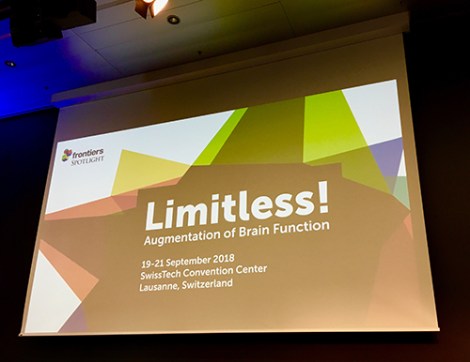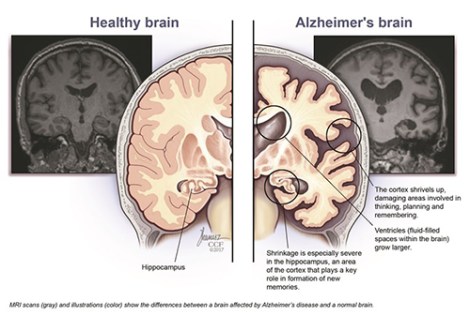Just a few weeks ago my husband and several of his collaborators held a conference in Lausanne, Switzerland, as part of a Spotlight Award from Frontiers, which was a very great honor for everyone involved. The conference was called Limitless! Augmentation of Brain Function. As you would imagine, much of the work presented in the conference focused around improving brain function, be it in relation to normal aging, senility, or even neurodevelopmental conditions.

Given my personal and professional investment in the study of neurodevelopmental conditions like autism, my favorite talk was given by Dr. Maria del Mar Dierrssen who works at the Center for Genomic Regulation in Spain. Her lecture focused on the treatment potential of green tea extract (specifically, a catechin within the extract called epigallocatechin-3-gallate or EGCG) on conditions like Down syndrome and Fragile X syndrome. So far, her lab has made some pretty impressive discoveries in the treatment of Down’s using what is essentially a dietary supplement and they are continuing that work in Fragile X.

Dr. Dierssen is an engaging, plucky, and enthusiastic woman who easily entranced me with her personality and impressive data. While I won’t discuss her presentation per se (as some of the data may not be published yet), I’m instead going to review work on EGCG and its treatment potential in a variety of conditions, including Down’s. Having read through more of the literature, I’m hopeful this could be a useful option for a wide variety of human conditions and a good preventative supplement. I have also recently begun using it in my own daily healthcare needs (5mg/kg) as it promotes cardiovascular, immune, hormone, and brain health to name just a few of the benefits. (Note, however, that its use is contraindicated in a number of health conditions, so please talk to your doctor about the specific brand of supplement and dosage you wish to take before starting.)
Down Syndrome
Even though most cases of Down syndrome are due to the triplication (trisonomy) of chromosome 21, leading to an overexpression of many of the affected genes, the primary mutation responsible for the cognitive phenotype is the protein kinase, DYRK1A. Back in 2003, Bain et al. found that the main polyphenol in green tea (EGCG) was a major inhibitor of DYRK1A protein’s activity [1]. Since DYRK1A is overexpressed in Down’s, an inhibitor of its activity is a potentially useful treatment.
Guedj et al. (2009) tested this idea using mice with partial chromosome 21 trisonomies (including the Dyrk1a gene) versus non-mutant controls, keeping half of the two groups on water and the other half on green tea. When tested behaviorally, mutant mice kept on green tea tested similar to their non-mutant siblings during various memory tasks, while mutant mice kept on water were comparatively deficient. When the scientists looked at overall brain volume, mutant mice on green tea also had volumes more similar to their non-mutant siblings than mutant mice kept on water. In addition, certain abnormal protein expressions in the brain (e.g., brain-derived neurotrophic factor or BDNF) were normalized in the mutants on green tea.
It was studies such as these that inspired Dr. Dierssen to form clinical trials of EGCG’s effectiveness on symptoms in Down syndrome. Since that time, she and her lab have completed a Phase I and continue work on Phase II clinical trials, pairing EGCG’s use with additional cognitive training [2, 3].
So far, the team has found that a 10mg/kg daily dose for 6-12 months is effective in significantly improving aspects of memory, executive function, and adaptive behavior in teenagers/young adults with Down’s. The team is also applying a similar treatment to cases of Fragile X syndrome so far with promising results, although I believe this work is still at an early stage. Given EGCG’s use in preventing and treating neurodegenetive disorders, it’s hoped it may also help prevent or at least delay the development of early onset Alzheimer’s in Down syndrome, which affects about half of people with the condition.
Green Tea’s Other Therapeutic Uses

Infection & Autoimmunity
Over 100 years ago, British Army surgeon, J. G. McNaught, reported the anti-infective ability of tea against typhoid fever (Salmonella typhi) [reviewed in 4]. As reviewed by Shrady et al. in that same year:
An interesting observation on the effect of an infusion of tea on the growth of Bacillus typhosus has been recorded by an English army surgeon, Major J. G. McNaught, in the Journal of the Royal Army Medical Corps for October, 1906. He finds that the germ in pure culture becomes greatly diminished in numbers by an exposure of four hours to the beverage. After twenty hours it was impossible to recover it at all from cold tea. The results obtained are of interest from the author’s standpoint with reference to the use of cold tea as a substitute for water in solders’ canteens during active service. For even when water is sufficiently sterilized, it is likely to become infected after sterilization, and bottles which have one been filled with contaminated water are capable of transmitting the infection for a long time. Tea, it would seem, however, will render any chance contamination with the typhoid bacillus harmless within a few hours.
EGCG appears to have antibacterial and antifungal effects via its ability to bind to the lipid (fatty) membranes of these cells and disrupt the folic acid cycle. Interestingly, EGCG seems to have even more potent antiviral capacity, which is achieved through a wide variety of mechanisms. Viruses that have been studied and are known to be vulnerable to EGCG include the families: Retroviridae (retroviruses like HIV), Orthomyxoviridae (e.g., influenza), Adenoviridae (adenoviruses), Reoviridae (rotoviruses), and Flaviviridae (e.g., hepatitis C, Zika, Dengue) [5].
Autoimmune disorders, like diabetes mellitus and Sjogren’s syndrome, also appear to respond well to EGCG [6, 7]. It’s believed that one of it’s mechanisms of action in reducing the severity of autoimmunity is via downregulating inflammatory T-cells and their pro-inflammatory molecules and upregulating activity of regulatory T (Treg) cells that help to reduce inflammation [8].
Senility & Brain Injury
Alzheimer’s and Parkinson’s diseases are respectively associated with abnormal accumulation of toxic amyloid-β and α-synuclein protein plaques in the brain. Surprisingly, EGCG, which is able to cross the blood-brain barrier into the brain, binds directly with precursors of these proteins and prevents them from forming their disease-associated toxic shapes [6]. What’s more, EGCG binds and converts already-formed toxic amyloid-β and α-synuclein fibrils into smaller non-toxic proteins, indicating that it may not only be useful in the prevention of these neurodegenerative diseases but in their respective treatments [9].

There is also some suggestion that EGCG application may help improve recovery following traumatic brain injury (TBI), although studies are currently few. While the mechanisms are not yet well understood given EGCG’s plethora of biochemical effects, research indicates that EGCG application prior to TBI and during recovery significantly decreases the extent of cell death following the injury and limits the extent of cognitive impairment [10, 11]. Following stroke, EGCG also increases the rate of neurogenesis and recovery [12].
Cancer & Cardiovascular Disease
Finally, two of the last major clinical areas of study into EGCG’s usefulness is cancer and cardiovascular disease. An earlier study look at the consumption of green tea in a Japanese population, finding that individuals who drank 10+ cups of tea per day experienced significantly less cancer as well as delays in cancer onset. They also were also less likely to die from cardiovascular disease than those individuals who drank less than 3 cups of tea per day [13]. Other studies have also suggested a reduced risk in ischemic stroke with greater tea consumption [reviewed in 14].
In terms of cancer treatment and prevention, EGCG limits cancer cell proliferation, suppresses certain molecular pathways vital in cancer’s growth and maintenance, and promotes cancer cell suicide (apoptosis). It’s been found to target a variety of cancers, including colon, prostate, breast, lung, and pancreatic cancers, and has even been shown to reduce metastasis (cancer spreading) [14, 15, 16, 17]. It has been considered as a potential adjuvant therapy in conjunction with traditional chemotherapies, although it also has the potential to antagonize certain chemotherapy drugs, which may ultimately limit its therapeutic use, but not its preventative one [18].
In terms of cardiovascular protection, EGCG seems to reduce bad cholesterol levels, high blood pressure, inflammation, and platelet aggregation, and improves endothelial cell function, which are the major cells that compose the vascular system. It also improves insulin sensitivity, presumably by mimicking insulin itself and stimulating important downstream pathways , increasing the likelihood of weight loss [19].
Brain Aging
One of the interesting prospects of Maria Dierssen’s and others’ work is its potential applicability to the maintenance of brain health during normal aging– something that, as another lecturer at the Limitless! conference pointed out, most of us take for granted until something goes wrong. But why not try to ameliorate the inevitable loss of neural connections and cells throughout life rather than attempting to heal a broken brain later on?
Many of us nowadays realize the importance of exercise and the role it plays in health maintenance. Why is the health of our brains one of the last things we think of? Almost 14% of people aged 71 and older have some form of dementia. Meanwhile, one-third of those aged 90+ have dementia. Since 1980, the number of people living past 90 has nearly tripled, which suggests that the number of dementia patients has also grown substantially.

While “exercising your brain” by staying engaged, interested, and learning new skills is a vital part of keeping it healthy, supplements like green tea extract may give us that extra boost and I look forward to further research in this exciting area of natural brain augmentation. Because, even if EGCG doesn’t extend the lengths of our lives all that much, it may at least help us maintain quality of life. After all, when we envision growing old in style, is it with chronic illness and impaired faculties? I know that’s not how I want to spent my twilight years.

Reblogged this on Cortical Chauvinism and commented:
This blog was written by my wife. We were both drawn to this possible intervention from a lecture we attended in while in Switzerland. I hope it is of benefit to our audience.
Sandy, In case you don’t receive this. Shirley